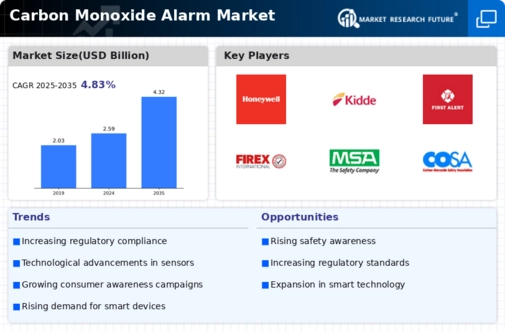Market Growth Projections
Expansion of the Real Estate Sector
The expansion of the real estate sector globally is a significant factor influencing the Global Carbon Monoxide Alarm Market Industry. As new residential and commercial properties are developed, the demand for safety features, including carbon monoxide alarms, increases. Builders and developers are increasingly incorporating these alarms into their designs to meet safety standards and attract buyers. This trend is particularly evident in regions experiencing rapid urbanization and population growth. Consequently, the market is poised for growth, with projections indicating a market value of 4.32 USD Billion by 2035, driven by the ongoing expansion of real estate and the associated safety requirements.
Regulatory Compliance and Standards
Regulatory frameworks and safety standards established by governmental bodies are pivotal in shaping the Global Carbon Monoxide Alarm Market Industry. Many countries have implemented stringent regulations mandating the installation of carbon monoxide alarms in residential and commercial properties. For example, legislation in various jurisdictions requires alarms to be installed in homes with fuel-burning appliances. This regulatory push not only enhances consumer safety but also stimulates market growth, as manufacturers strive to meet compliance requirements. As a result, the market is expected to grow, with projections indicating a value of 4.32 USD Billion by 2035, driven by the need for adherence to these regulations.
Technological Advancements in Alarm Systems
Technological innovations in carbon monoxide alarm systems are transforming the Global Carbon Monoxide Alarm Market Industry. Modern alarms now feature advanced technologies such as smart connectivity, enabling users to receive alerts on their smartphones. These enhancements improve user experience and increase the effectiveness of detection. The integration of artificial intelligence and machine learning in alarm systems allows for more accurate detection and reduced false alarms. As consumers increasingly seek smart home solutions, the demand for technologically advanced carbon monoxide alarms is likely to rise, contributing to a projected compound annual growth rate of 4.76% from 2025 to 2035.
Rising Incidence of Carbon Monoxide Poisoning
The rising incidence of carbon monoxide poisoning incidents globally serves as a critical driver for the Global Carbon Monoxide Alarm Market Industry. Reports indicate that thousands of individuals are affected by carbon monoxide exposure each year, prompting a heightened need for effective detection solutions. This alarming trend has led to increased public awareness and a subsequent rise in demand for carbon monoxide alarms. As communities recognize the importance of preventive measures, the market is expected to expand significantly, with projections suggesting a market value of 2.59 USD Billion in 2024. This growth reflects the urgent need for safety solutions in both residential and commercial environments.
Increasing Awareness of Carbon Monoxide Dangers
The growing awareness regarding the dangers of carbon monoxide poisoning significantly drives the Global Carbon Monoxide Alarm Market Industry. Educational campaigns by health organizations and government agencies have highlighted the risks associated with carbon monoxide exposure, leading to increased consumer demand for detection devices. For instance, in 2024, the market is projected to reach 2.59 USD Billion, reflecting a heightened focus on safety measures in residential and commercial settings. This awareness is particularly crucial in regions with high incidences of carbon monoxide-related incidents, prompting homeowners and businesses to invest in alarms to safeguard their environments.









